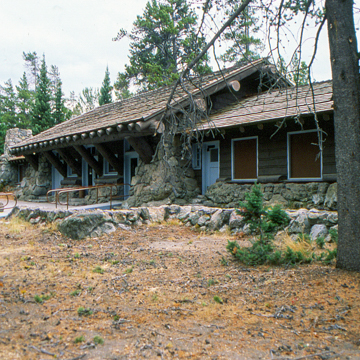Fishing Bridge Museum is the largest of Yellowstone National Park’s three extant trailside museums and is located on the north shore of Yellowstone Lake in the center of the park. The museum is nestled in trees at the end of a parking lot, far from the Park road that directs traffic to the campground, gas station, general store, and on to Sylvan Pass. Its floor plan and exterior photograph were featured in the National Park Service’s 1938 survey, Park and Recreation Structures, with the following caption: “This well-planned and well-lighted nature museum is a successful example of the employment of principles important in the creating of buildings suitable to natural areas—the value of the free-hand line, the avoidance of underscale, and the pleasing quality of the furrowed and knotted log.”
Built in 1930–1931, the one-story building is long and linear, and symmetrical along both axes, with the exception of the terraces and the massive stone chimney at the northeast end. The center core and flanking wings of the building are protected with side gable roofs, accentuated with jerkinheads at each end. The pronounced ground-hugging solidity of the building is provided by the markedly battered rough boulder columns and base that cascade down the walls. This heavy waterfall of stone is balanced with lightweight wood-clad walls and openings in every bay. The wider central building portion is prominent, with a higher ridge line and entry doors in every other bay. The eaves of all the roofs extend far beyond the building walls and are supported by log rafters. The upper walls are finished with thin wood shingles laid in double courses that form gentle waves across the wall surface. The wood roof shingles are articulated as well, with doubling every fifth course. This whole assemblage is defined with low stone walls at the terrace fringes that help direct traffic flow.
The interior of Fishing Bridge Museum is simple and light-filled. The cool plaster walls are repeatedly punched with windows, doors, and transoms and the roof displays its structure in honey-colored wood. Historic stuffed mounts of the region’s birds and animals are displayed throughout the interior, supplemented with interpretative signs.
References
Bryant, Harold C., and Wallace W. Atwood, Jr. Research and Education in the National Parks - Part I: The Educational Program in the National Parks. Washington, D.C.: U.S. Department of the Interior, National Park Service, 1932.
Good, Albert, and Randall J. Biallas. Park and Recreation Structures. 1938. Reprint, New York: Princeton Architectural Press, 1999.
Harrison, Laura Soulliere. Architecture in the Parks National Historic Landmark Theme Study. Washington, DC: U.S. Department of the Interior, National Park Service, 1986.

